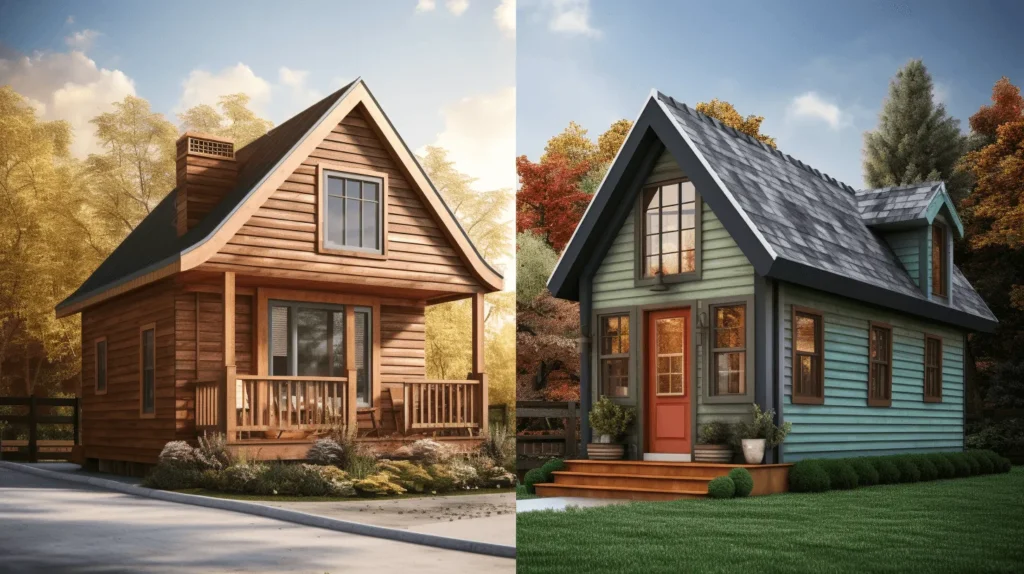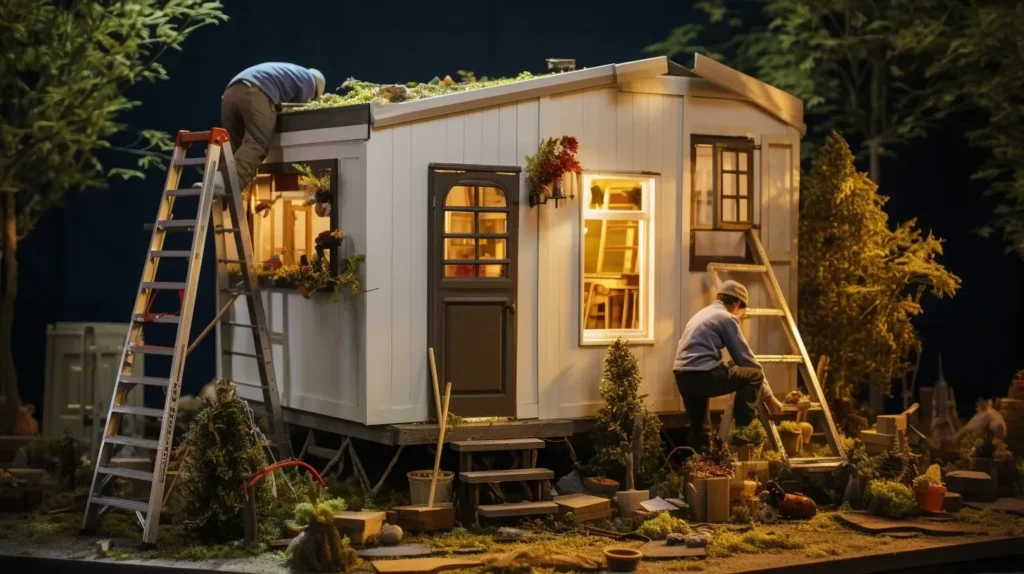Welcome, dear reader, to the ultimate showdown concerning tiny house vs traditional home cost. We seek to go deep into the details about the differences of costs and also look at the pros and cons of each and which is more bang for buck based on what you get. Today, we’re diving deep into the heart of the matter. Buckle up; it’s going to be a wild ride!
Round 1: The Mighty Tiny House
Ladies and gentlemen, let’s talk about the underdog with a heart of gold—the tiny house! Picture this: you’re searching for a home that won’t break the bank, and in comes the tiny house, swinging with an affordable price tag. These diminutive dwellings typically range from $20,000 to $100,000, making them a wallet-friendly contender in the housing market.
One of the tiny house’s knockout punches in the cost department is its size. With a smaller footprint, you’ll pay less for materials, construction, and maintenance. It’s like getting a cozy, budget-friendly apartment on wheels. And speaking of wheels, many tiny houses are mobile, allowing you to explore new horizons without the astronomical price tag of a traditional home.
But wait, there’s more! The tiny house goes the extra mile in cost savings by boasting lower utility bills. With reduced square footage, heating, cooling, and electricity costs are significantly reduced. It’s like a little financial spa day for your wallet.
However, like any contender, the tiny house has its limitations. Its compact size means limited storage and a more confined living space. So, if you’re a collector of life’s little treasures or have a growing family, you might find yourself in a tight spot.
In Round 1, the mighty tiny house proves that great things come in small packages, offering a budget-friendly option that champions minimalist living and cost savings. So, are you ready to step into the ring with a tiny house and emerge victorious on the financial front? The choice is yours!
Round 2: The Traditional Titan
In this corner, we have the reigning champion of the housing world—the traditional home! It’s big, it’s bold, and it’s known for offering generous living spaces. But can it go toe-to-toe with the scrappy tiny house in terms of cost-effectiveness? Let’s find out!
The traditional home, with its vast square footage, stands as a symbol of spaciousness and luxury. But, of course, with size comes cost. The average price of a traditional home in the United States hovers around $300,000 to $400,000, making it a heavyweight contender in terms of price. It’s like buying a grand mansion in the housing arena.
While a traditional home offers ample room for storage, entertaining guests, and accommodating a growing family, it also comes with higher maintenance and utility expenses. Heating and cooling a larger space can lead to substantial monthly bills, and the cost of repairs and renovations can add up quickly.
But here’s the knockout punch in favor of the traditional titan: its potential for long-term appreciation in value. Over time, traditional homes tend to increase in value, offering a potentially profitable investment.
In Round 2, the traditional home showcases its spaciousness and potential for long-term value. It’s a heavyweight contender, but it also packs a hefty price tag. So, are you willing to pay the big bucks for the roomy luxury of a traditional home, or will you opt for the nimbleness and affordability of the tiny house? The decision is yours!
The Pros and Cons Face-off
Tiny House Pros:
Lower Initial Cost: Tiny houses come out swinging in the first round with their affordable price tags. They pack a punch when it comes to cost-effectiveness, making them a knockout choice for budget-conscious buyers.
Minimalist Lifestyle: Living in a tiny house encourages a minimalist lifestyle. It teaches you to declutter and focus on what truly matters, emphasizing quality over quantity.
Lower Utility Bills: Tiny houses land another solid punch by delivering lower utility bills. With less square footage to heat, cool, and light, your monthly expenses take a dive.
Reduced Environmental Footprint: In the eco-friendly corner, tiny houses shine as champions of sustainability. They leave a smaller carbon footprint, promoting greener living.
Easier to Clean and Maintain: When it comes to maintenance, tiny houses are quick on their feet. Cleaning and upkeep are a breeze due to their compact size.
Mobility: Perhaps the most agile contender in this matchup, tiny houses offer mobility. You can pack up and move your house whenever you please, giving you the freedom to explore new horizons.
Tiny House Cons:
Limited Living Space: The first challenge tiny houses face is limited living space. While cozy, it may not suit everyone’s lifestyle or needs.
Zoning and Legal Challenges: Zoning laws and legal restrictions can be formidable opponents for tiny house dwellers. Finding a legal spot to park your tiny home can be a real battle.
Smaller Kitchen and Bathroom: Tiny houses may deliver a punch when it comes to affordability, but they have a smaller kitchen and bathroom, which can be a drawback for some.
Potential for Claustrophobia: The tight quarters can be a tough contender for those prone to claustrophobia. It’s important to consider whether you can thrive in such close quarters.
Fewer Storage Options: Storage space is limited in tiny houses, making it essential to downsize your belongings. Not everyone is ready for this fight.
Might Not Be Suitable for a Growing Family: If your family is growing, a tiny house may not be up for the challenge. It can become cramped as your family expands.
Traditional Home Pros:
Ample Living Space: Traditional homes come into the ring with their heavyweight advantage—ample living space. They offer room to stretch out and breathe.
Higher Property Value: These homes have a history of holding their value and often appreciate over time, making them a solid investment.
More Storage Options: Traditional homes offer plenty of storage options, ensuring that you won’t have to fight for space for your belongings.
Space for a Growing Family: In the family-friendly corner, traditional homes shine. They provide room for a growing family without feeling cramped.
Established Neighborhoods and Amenities: Traditional homes often come with established neighborhoods, amenities, and a sense of community.
Stable and Reliable Investment: When it comes to long-term investment, traditional homes are a reliable choice. They tend to appreciate steadily over the years.
Traditional Home Cons:
Higher Initial Cost: The first blow against traditional homes is their higher initial cost. They require a bigger budget for the purchase.
Hefty Maintenance Bills: Maintenance expenses can be a tough contender for traditional homeowners. The larger the home, the more costly repairs and upkeep can become.
Higher Utility Bills: Traditional homes often deliver higher utility bills due to their larger size, which can be a financial challenge.
Property Taxes: Property taxes can give traditional homeowners sticker shock, impacting their monthly expenses.
Not as Eco-friendly: In the green corner, traditional homes struggle to compete with tiny houses. They tend to have a larger environmental impact.
The Verdict: Tiny House Vs Traditional Home Cost
In this epic showdown, there’s no one-size-fits-all answer. It all comes down to your preferences, lifestyle, and budget. If you crave simplicity, lower costs, and a minimalist lifestyle, the tiny house might be your knight in shining armor. But if space, status, and room to grow are your game, then the traditional home takes the crown.
Ultimately, it’s your story, your adventure, and your choice. Whether you opt for tiny or traditional, what matters most is that your home feels like your castle. So, what’ll it be? Tiny or traditional? The choice is yours, brave homeowner! Please share, so others learn what you did, spread the tiny house love!


